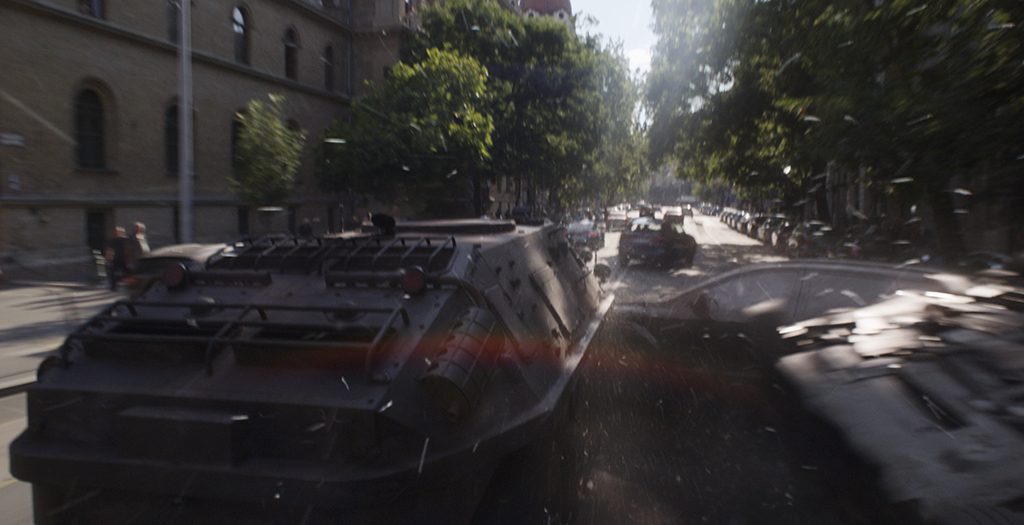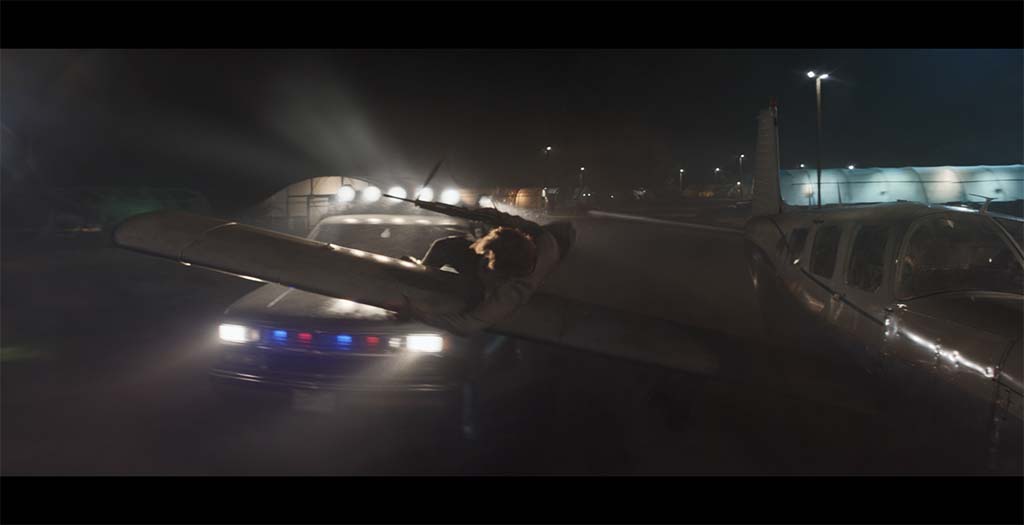Serving as a bridge between Captain America: Civil War and Avengers: Infinity War, Scarlett Johansson finally gets to take center stage with the release of Black Widow. With four weeks left in post-production, the coronavirus lockdown occurred, but like the title character, Marvel Studios Visual Effects Supervisor Geoffrey Baumann (Black Panther) was able to regain his footing and complete the mission of providing a swan song for the deadly assassin from Russia.
“At that point in the show, often I will take a good monitor and work from home anyway. We kept going and had our studio reviews as best we could through different screenshare assets like ClearView. Some of the vendors had been moving towards work at home, or the ability to move people around from different cities and having work stations in Las Vegas and remoting in. We didn’t have all of our vendors go down at the same time, so we were able to transfer our focus from one vendor to another.”
Filmmaker Cate Shortland (Lore) had never directed a visual effects-heavy production before, with 2,467 shots being created by ILM, Weta Digital, Digital Domain, Scanline VFX, Cinesite, Trixter, SSVFX and Mammal Studios. “More than any director I’ve worked with, Cate put together teasers of content that she liked from music videos, imagery and other films, and it would be cut together with music or a soundtrack,” states Baumann. “Cate did one for the freefall, the opening in Ohio and Budapest car chase. The teasers gave us an understanding of where she wanted to take it. Cate also put together a huge mood book that the visual effects team printed out. The images were placed on a wall situated at the entrance of our office. She would ask me about my thoughts on character or story. It was great to be involved with her on that level, which in turn helped me to guide her through the visual effects and to understand her aesthetic. Cate often used the word ‘beautiful.’”
Comparisons have been made to Captain America: The Winter Soldier, in particular the aerial battle that happens in the third act which results in the destruction of the Red Room. “I was the second unit visual effects supervisor on Winter Soldier and also worked on the ‘barrel of monkeys’ sequence in Iron Man 3 where they fall out of Air Force One. Early on, the freefall sequence was something that kept me up in the sense that I knew it was going to be challenging for visual effects and shooting. We ended up using a wind tunnel, a robotic arm and wirework – that was something I leaned into from my experience of Iron Man 3. It is also compared to the Helicarriers in The Winter Soldier when Falcon is flying around the two Helicarriers.

2,467 shots were produced by Marvel Studios Visual Effects Supervisor Geoffrey Baumann, who was helped by having practical sets and locations.
“Early on, the freefall sequence was something that kept me up in the sense that I knew it was going to be challenging for visual effects and shooting. We ended up using a wind tunnel, a robotic arm and wirework – that was something I leaned into from my experience of Iron Man 3. … The freefall was primarily CG with a practical character. One of the difficult parts there is, if you’re using the wind tunnel are you going to get enough wind to have it be real or do you already commit to CG hair? We ended up going with more CG hair than I initially anticipated.”
—Geoffrey Baumann, Visual Effects Supervisor, Marvel Studios
We didn’t quite know exactly what the Red Room would look like, but Cate kept coming back to brutalist architecture. The shape was changed because there was concern of it being a Russian version of a Helicarrier. The freefall was primarily CG with a practical character. One of the difficult parts there is, if you’re using the wind tunnel are you going to get enough wind to have it be real or do you already commit to CG hair? We ended up going with more CG hair than I initially anticipated.”


ILM created a digital version of the practical armored vehicle constructed by the special effects team for the Budapest chase sequence.


ILM created a digital double for Alexei (David Harbour) for the opening sequence where he fires upon law enforcement vehicles while on the wing of the escaping airplane.
“More than any director I’ve worked with, Cate [Shortland] put together teasers of content that she liked from music videos, imagery and other films, and it would be cut together with music or a soundtrack. Cate did one for the freefall, the opening in Ohio and Budapest car chase. The teasers gave us an understanding of where she wanted to take it. Cate also put together a huge mood book that the visual effects team printed out. The images were placed on a wall situated at the entrance of our office. She would ask me about my thoughts on character or story. It was great to be involved with her on that level, which in turn helped me to guide her through the visual effects and to understand her aesthetic.”
—Geoffrey Baumann, Visual Effects Supervisor, Marvel Studios



Plates were shot in Svalbard, Norway to provide the setting for the gulag.
An armored vehicle driven by the Taskmaster (Olga Kurylenko) barrels through the streets and cars in Budapest in pursuit of Natasha Romanoff (Scarlett Johansson) and Yelena Belova (Florence Pugh). “There were a lot of cars that were added and augmented,” explains Baumann. “The armored car itself was a practical build by Paul Corbould [Dunkirk] and his special effects team. I believe that they built two from scratch. The parts where we helped are when the cars didn’t quite buckle or break apart as we might have liked. The big launch with the arrow blowing up under the BMW was a practical gag that we helped to clean up the rigs.”
Yelena slams a car door and knocks a widow off of her bike. “Our additional Visual Effects Supervisor, Jesse James Chisholm, along with second unit director Darrin Prescot, came up with this idea. It was a great example of practical stunt and camera work merged with visual effects, a practical stunt where the car does the 180 driving backwards, Yelena mimes kicking the door open, and we added a CG door and CG lamppost. The motorcycle was driven by a stunt performer and was on a wire that stops the bike at the end of its length, launching the rider off over the handle bars. To assist with timing and to not miss the stunt, each side of the gag was shot separately. The plates were then merged as the camera tilts up and over with the door, eventually tilting down with the widow as she slides to a stop.”
Plates were shot in Svalbard, Norway to provide the setting for the gulag. “I always prefer to find a real location even if it becomes all CG,” states Baumann. “The interior was a location in London called the Daily Mail and the exterior was built at Pinewood.” Lighting was essential in seamlessly integrating the different plate elements. “You need to make sure that you’re shooting at the right time of day,” observes Baumann. “Generally, if you have one piece that has heavy atmosphere, the rest of them are going to have to match. If the DP is willing to minimize the amount of atmosphere, we have a better chance to get all of the pieces to work and can add the atmosphere later. We did add light snow flurries in the gulag. The helicopter was on a gimbal. It was challenging because you’re dealing with eyelines and have to make sure that scale and proximity of people are working. [Production Designer] Charles Wood took the information that we gathered from the mountains, ingested it back into the art department, redesigned with new information, and gave it back to us.”
The opening sequence in Ohio has Alexei (David Harbour) on the wing of a plane firing at pursuing police cars. “First unit began the scene and the second unit cleaned up the end part of the chase. The majority of the work with David on the wing and the kids in the plane was all process work afterwards with Cate on bluescreen with LED screens running the footage. We weren’t trying to go for pixel finals like The Mandalorian, but to get some kind of interactive light back onto the vehicle and characters. It was great having a 360-degree array of the action playing out on LED screens in front of the performers in their gimbal airplane because they could see what’s happening. It also allowed for the lighting department to put headlights onto the plane at the right time.”
The biggest challenge was the third act, says Baumann. “That includes Dreykov’s [Ray Winston] office in the Red Room, which has screens going down to the ground. It is where all of the different storylines merged and needed to make sense. If you change continuity and then everything breaks. It kept me up for awhile!”
